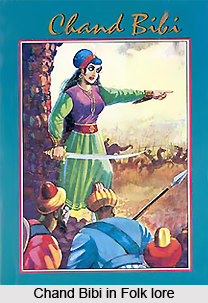 Chand Bibi also known as Chand Khatun or Chand Sultana was a woman warrior who positioned herself as a rebellious counterpart in her self willed struggle for freedom. She acted as the Regent of Bijapur (1580-90) as well as the Regent of Ahmednagar (1596-99). She acted as the wall for Ahmednagar and in the history of India as well as humanity she is best known for defending Ahmednagar against the Mughal forces of Emperor Akbar.
Chand Bibi also known as Chand Khatun or Chand Sultana was a woman warrior who positioned herself as a rebellious counterpart in her self willed struggle for freedom. She acted as the Regent of Bijapur (1580-90) as well as the Regent of Ahmednagar (1596-99). She acted as the wall for Ahmednagar and in the history of India as well as humanity she is best known for defending Ahmednagar against the Mughal forces of Emperor Akbar.
Early Life of Chand Bibi
Chand Bibi was the daughter of Hussain Nizam Shah I of Ahmednagar as well as the sister of Burhan-ul-Mulk, the Sultan of Ahmednagar. She was acquainted with many languages including Arabic, Persian, Turkish, Marathi and Kannada. Creativity was as if in her character and her feature, she played sitar and painting flowers was her hobby. As a part of an alliance policy, Chand Bibi tied the nuptial knots to Ali Adil Shah I of the Bijapur Sultanate. A step well (bawdi) that was constructed by her husband near the eastern boundary of Bijapur was named Chand Bawdi after her.
Career of Chand Bibi
Kishvar Khan was duly crowned as the second regent of Ibrahim and in a battle fought against Ahmednagar; the Sultanate at Dharaseo, the Bijapur army led by him captured all the artillery and elephants of the enemy army. It was after the victory that Kishvar Khan that ordered other Bijapuri generals to surrender the elephants captured.
Ikhlas Khan was finally crowned as the regent but he was dismissed by Chand Bibi shortly afterwards. As soon as he resumed his power, position and dictatorship, he was soon challenged by the other Habshi generals. As political state of affairs of a state demands, the then situation in Bijapur, Ahmednagar`s Nizam Shahi sultan allied with the Qutb Shahi of Golconda to ultimately attack Bijapur. Troops at Bijapur were not adequate to repulse the joint attack and very soon the Habshi generals realized that they could not defend the city alone and gave up their chivalrous honour before Chand Bibi. Abu-ul-Hassan, a Shi`a general appointed by Chand Bibi, called for the Maratha forces in Carnatic and the Marathas duly attacked the invaders` supply lines forcing the Ahmednagar-Golconda contingency army to retreat finally.
In the year 1591 Mughal emperor Akbar out of his sheer power demonstration summoned all the Deccan sultanates to acknowledge his supremacy. All the sultanates evaded acquiescence and then the ambassadors of Akbar returned in 1593. In 1595, Ibrahim Nizam Shah, the monarch of Ahmednagar Sultanate was assassinated in a relentless scuffle mercilessly in a region which is about 40 miles from Ahmednagar at Shahdurg against Ibrahim Adil Shah II of Bijapur. After he died, some of the nobles felt that his newborn son Bahadur Shah must be declared as the King under the regency of Chand Bibi (his father`s aunt).
It was the Deccani minister Miyan Manju who made the proclamation that the twelve-year old son of Shah Tahir, Ahmad Shah II would be the ruler from August 6, 1595. The Habshi nobles of Ahmednagar, led by Ikhlas Khan, were divergently opposed to this plan. Conspicuously as there was the sea of faced turbulence and roaring dissatisfied dissent among the nobles, Miyan Manju was almost forced to invite Akbar`s son Shah Murad to march his army to Ahmednagar. Murad arrived to Malwa, where he joined Mughal forces led by Abdul Rahim Khan-I-Khana. Raja Ali Khan joined them at Mandu, and the united army advanced on Ahmednagar.
When Murad was on a march to Ahmednagar, an assortment of noblemen Ikhlas Khan joined Miyan Manju. Miyan Manju defeated Ikhlas Khan and other opponents. He regretted in a due course having invited the Mughals, but it was too late. He requested Chand Bibi to accept the regency at Ahmednagar, with Ahmed Shah II. Ikhlas Khan afterwards escaped to Paithan, where he was attacked and overpowered by the Mughals.
Chand Bibi accepted the regency and proclaimed Bahadur Shah King of Ahmednagar



















